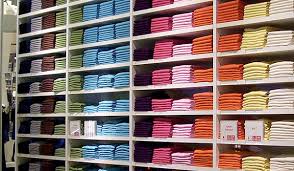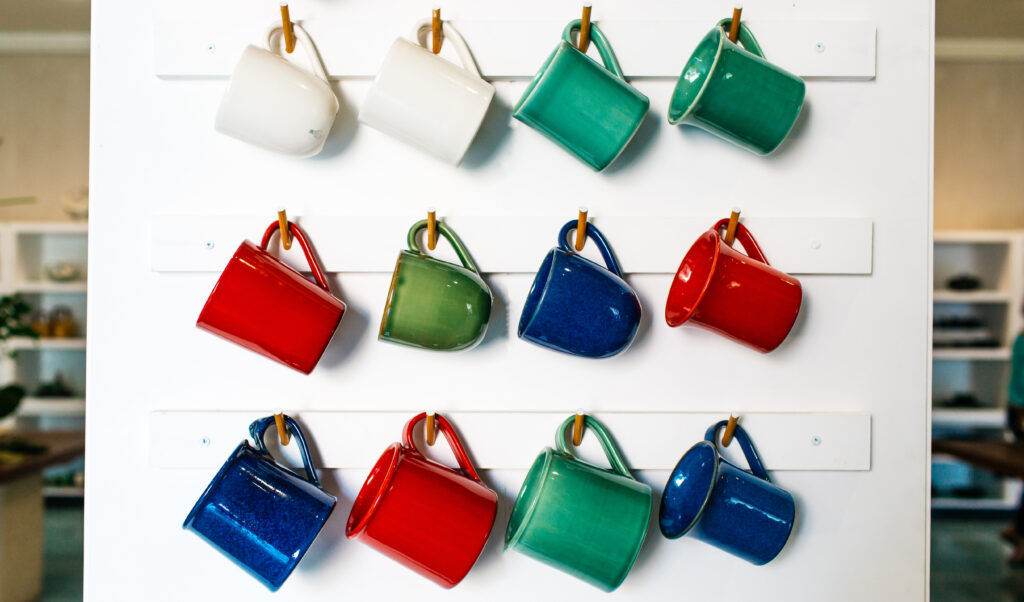“Before anything else, preparation is the key to success.” –Alexander Graham Bell
If you want to be a successful online retailer, you need to prepare a good system for managing inventory, especially if you have a multichannel strategy. Good inventory management starts with the SKU.
What is a SKU?
A stock keeping unit or SKU (pronounced “skew”) is the unique identifier or code assigned to a specific product that is used for inventory tracking purposes. For instance, if you sell a shirt in 3 different sizes (Small, Medium, Large) and 3 different colors (Red, Green, Blue), each size and color combo would have its own inventory and therefore have its own SKU as well.
A SKU is not the same as a product model number from a manufacturer or a UPC number. The SKU is created and assigned by you, the merchant, to identify and track your own inventory and should be constructed in a way that has meaning to you. In fact, most good retailers can identify their products by the SKU alone.
 Why SKUs are important
SKUs are important and useful as a common reference for tracking inventory across every part of your business. While the title or description of your products may change slightly depending on the use (such as on a purchase order or in a listing on a sales channel), the SKU will remain consistent and allow you to positively identify the item between systems. This will also be helpful when filtering or sorting inventory or sales reports.
This is especially true for merchants with a multichannel sales strategy. If you sell on your own webstore as well as on eBay and Amazon, you are very likely to have different product titles for the same item on each of these sales channels. But using the same SKU on each channel will tie these listings together when you use a multichannel solution like Sellbrite to manage your business.
Sellbrite will automatically “link” listings with the same SKU to the matching product inventory in the system. That way, when you get an order for an item, our system will use the SKU to subtract the quantity sold from the correct inventory item and then update the quantities of all the other listings on other channels that are linked to that inventory. Without SKUs, this would be a very manual process and prone to errors.
How to construct a SKU
Why SKUs are important
SKUs are important and useful as a common reference for tracking inventory across every part of your business. While the title or description of your products may change slightly depending on the use (such as on a purchase order or in a listing on a sales channel), the SKU will remain consistent and allow you to positively identify the item between systems. This will also be helpful when filtering or sorting inventory or sales reports.
This is especially true for merchants with a multichannel sales strategy. If you sell on your own webstore as well as on eBay and Amazon, you are very likely to have different product titles for the same item on each of these sales channels. But using the same SKU on each channel will tie these listings together when you use a multichannel solution like Sellbrite to manage your business.
Sellbrite will automatically “link” listings with the same SKU to the matching product inventory in the system. That way, when you get an order for an item, our system will use the SKU to subtract the quantity sold from the correct inventory item and then update the quantities of all the other listings on other channels that are linked to that inventory. Without SKUs, this would be a very manual process and prone to errors.
How to construct a SKU
 A good SKU is made up of letters and numbers and usually includes details about the product, such as the brand/manufacturer, model number, size, and color. Dashes or periods may also be included to separate meaningful pieces of the SKU. For example, a SKU for that shirt you sell in size Medium and color Blue might be
CAL-LS3454-MD-BLU.
Everyone has their own way of constructing SKUs and there is no “correct” way, but there are definitely things not to do. Here is the method I use and have found to be most useful. Let’s break down our example above.
CAL-LS3454-MD-BLU
First, assign 3 letters to represent the brand/manufacturer of the product. In our example above, I assigned “CAL” since this is a Calvin Klein shirt. I could have used any other letters, like “CLK” or “CKN”, as long as you know what it means and can identify it later. Never use the same 3 letters for different brands. We’ll follow these letters with a dash (-) to make it easy to see and read.
CAL-LS3454-MD-BLU
Next, I like to use the style number or model number of the product that was assigned by the manufacturer. This number is the same across all variations of the product, and therefore is useless on its own to track inventory. But it makes it easy to reference later and determine which shirt this actually is (for example, the long-sleeved, striped, button down shirt). Of course, if you make your own products or sell products that don’t have a style number then this is not going to work for you. So you should try to use or create another short, unique code that will forever identify that particular model/style of product. In this example, we may use LSBUTTON, short for “long-sleeved button down”, instead. We’ll follow it with another dash (-).
CAL-LS3454-MD-BLUE
Finally, if necessary, you’ll add a series of 2- or 3-digit codes (letters or numbers) to identify and describe the elements that make this a unique inventory item, such as the color and size. In our example, we us MD to signify that this is the Medium shirt and BLU to indicate the color Blue. Again, whatever is easiest for you to remember and identify later.
So if I get an order later for the product with SKU of CAL-A3454-MD-BLU, I will know that it is the Calvin Klein long-sleeved, striped, button down shirt in Medium, Blue.
Best Practices for SKUs
A good SKU is made up of letters and numbers and usually includes details about the product, such as the brand/manufacturer, model number, size, and color. Dashes or periods may also be included to separate meaningful pieces of the SKU. For example, a SKU for that shirt you sell in size Medium and color Blue might be
CAL-LS3454-MD-BLU.
Everyone has their own way of constructing SKUs and there is no “correct” way, but there are definitely things not to do. Here is the method I use and have found to be most useful. Let’s break down our example above.
CAL-LS3454-MD-BLU
First, assign 3 letters to represent the brand/manufacturer of the product. In our example above, I assigned “CAL” since this is a Calvin Klein shirt. I could have used any other letters, like “CLK” or “CKN”, as long as you know what it means and can identify it later. Never use the same 3 letters for different brands. We’ll follow these letters with a dash (-) to make it easy to see and read.
CAL-LS3454-MD-BLU
Next, I like to use the style number or model number of the product that was assigned by the manufacturer. This number is the same across all variations of the product, and therefore is useless on its own to track inventory. But it makes it easy to reference later and determine which shirt this actually is (for example, the long-sleeved, striped, button down shirt). Of course, if you make your own products or sell products that don’t have a style number then this is not going to work for you. So you should try to use or create another short, unique code that will forever identify that particular model/style of product. In this example, we may use LSBUTTON, short for “long-sleeved button down”, instead. We’ll follow it with another dash (-).
CAL-LS3454-MD-BLUE
Finally, if necessary, you’ll add a series of 2- or 3-digit codes (letters or numbers) to identify and describe the elements that make this a unique inventory item, such as the color and size. In our example, we us MD to signify that this is the Medium shirt and BLU to indicate the color Blue. Again, whatever is easiest for you to remember and identify later.
So if I get an order later for the product with SKU of CAL-A3454-MD-BLU, I will know that it is the Calvin Klein long-sleeved, striped, button down shirt in Medium, Blue.
Best Practices for SKUs
 Why SKUs are important
SKUs are important and useful as a common reference for tracking inventory across every part of your business. While the title or description of your products may change slightly depending on the use (such as on a purchase order or in a listing on a sales channel), the SKU will remain consistent and allow you to positively identify the item between systems. This will also be helpful when filtering or sorting inventory or sales reports.
This is especially true for merchants with a multichannel sales strategy. If you sell on your own webstore as well as on eBay and Amazon, you are very likely to have different product titles for the same item on each of these sales channels. But using the same SKU on each channel will tie these listings together when you use a multichannel solution like Sellbrite to manage your business.
Sellbrite will automatically “link” listings with the same SKU to the matching product inventory in the system. That way, when you get an order for an item, our system will use the SKU to subtract the quantity sold from the correct inventory item and then update the quantities of all the other listings on other channels that are linked to that inventory. Without SKUs, this would be a very manual process and prone to errors.
How to construct a SKU
Why SKUs are important
SKUs are important and useful as a common reference for tracking inventory across every part of your business. While the title or description of your products may change slightly depending on the use (such as on a purchase order or in a listing on a sales channel), the SKU will remain consistent and allow you to positively identify the item between systems. This will also be helpful when filtering or sorting inventory or sales reports.
This is especially true for merchants with a multichannel sales strategy. If you sell on your own webstore as well as on eBay and Amazon, you are very likely to have different product titles for the same item on each of these sales channels. But using the same SKU on each channel will tie these listings together when you use a multichannel solution like Sellbrite to manage your business.
Sellbrite will automatically “link” listings with the same SKU to the matching product inventory in the system. That way, when you get an order for an item, our system will use the SKU to subtract the quantity sold from the correct inventory item and then update the quantities of all the other listings on other channels that are linked to that inventory. Without SKUs, this would be a very manual process and prone to errors.
How to construct a SKU
 A good SKU is made up of letters and numbers and usually includes details about the product, such as the brand/manufacturer, model number, size, and color. Dashes or periods may also be included to separate meaningful pieces of the SKU. For example, a SKU for that shirt you sell in size Medium and color Blue might be
CAL-LS3454-MD-BLU.
Everyone has their own way of constructing SKUs and there is no “correct” way, but there are definitely things not to do. Here is the method I use and have found to be most useful. Let’s break down our example above.
CAL-LS3454-MD-BLU
First, assign 3 letters to represent the brand/manufacturer of the product. In our example above, I assigned “CAL” since this is a Calvin Klein shirt. I could have used any other letters, like “CLK” or “CKN”, as long as you know what it means and can identify it later. Never use the same 3 letters for different brands. We’ll follow these letters with a dash (-) to make it easy to see and read.
CAL-LS3454-MD-BLU
Next, I like to use the style number or model number of the product that was assigned by the manufacturer. This number is the same across all variations of the product, and therefore is useless on its own to track inventory. But it makes it easy to reference later and determine which shirt this actually is (for example, the long-sleeved, striped, button down shirt). Of course, if you make your own products or sell products that don’t have a style number then this is not going to work for you. So you should try to use or create another short, unique code that will forever identify that particular model/style of product. In this example, we may use LSBUTTON, short for “long-sleeved button down”, instead. We’ll follow it with another dash (-).
CAL-LS3454-MD-BLUE
Finally, if necessary, you’ll add a series of 2- or 3-digit codes (letters or numbers) to identify and describe the elements that make this a unique inventory item, such as the color and size. In our example, we us MD to signify that this is the Medium shirt and BLU to indicate the color Blue. Again, whatever is easiest for you to remember and identify later.
So if I get an order later for the product with SKU of CAL-A3454-MD-BLU, I will know that it is the Calvin Klein long-sleeved, striped, button down shirt in Medium, Blue.
Best Practices for SKUs
A good SKU is made up of letters and numbers and usually includes details about the product, such as the brand/manufacturer, model number, size, and color. Dashes or periods may also be included to separate meaningful pieces of the SKU. For example, a SKU for that shirt you sell in size Medium and color Blue might be
CAL-LS3454-MD-BLU.
Everyone has their own way of constructing SKUs and there is no “correct” way, but there are definitely things not to do. Here is the method I use and have found to be most useful. Let’s break down our example above.
CAL-LS3454-MD-BLU
First, assign 3 letters to represent the brand/manufacturer of the product. In our example above, I assigned “CAL” since this is a Calvin Klein shirt. I could have used any other letters, like “CLK” or “CKN”, as long as you know what it means and can identify it later. Never use the same 3 letters for different brands. We’ll follow these letters with a dash (-) to make it easy to see and read.
CAL-LS3454-MD-BLU
Next, I like to use the style number or model number of the product that was assigned by the manufacturer. This number is the same across all variations of the product, and therefore is useless on its own to track inventory. But it makes it easy to reference later and determine which shirt this actually is (for example, the long-sleeved, striped, button down shirt). Of course, if you make your own products or sell products that don’t have a style number then this is not going to work for you. So you should try to use or create another short, unique code that will forever identify that particular model/style of product. In this example, we may use LSBUTTON, short for “long-sleeved button down”, instead. We’ll follow it with another dash (-).
CAL-LS3454-MD-BLUE
Finally, if necessary, you’ll add a series of 2- or 3-digit codes (letters or numbers) to identify and describe the elements that make this a unique inventory item, such as the color and size. In our example, we us MD to signify that this is the Medium shirt and BLU to indicate the color Blue. Again, whatever is easiest for you to remember and identify later.
So if I get an order later for the product with SKU of CAL-A3454-MD-BLU, I will know that it is the Calvin Klein long-sleeved, striped, button down shirt in Medium, Blue.
Best Practices for SKUs
- Make them unique – Create a unique SKU for each inventory item you sell and never reuse a SKU for an item you don’t sell anymore.
- Keep it short – SKUs should be no more than about 30 characters long. Any longer than that and they become difficult to read and also may not work with some inventory management systems.
- Never use spaces or special characters – Stick with simple characters that will not confuse people or software systems. Only use dashes or periods as separators, and NEVER use spaces, slashes (/ or \), “&”, “%”, “?”, quotes, commas or other special characters.
- Don’t just use the product title – Leave the long descriptions for the product title, not the SKU.
- Never start your SKU with a zero – Unless you want to make your life miserable, don’t start your SKU with a 0. Excel and other spreadsheet software will strip out the 0 and mess everything up. Just don’t do it.
- Avoid using letters that can be confused with numbers, such as O,I, and L.


1 thought on “Here’s Why You Should Care About Using SKUs”
Very Good information for the new commers